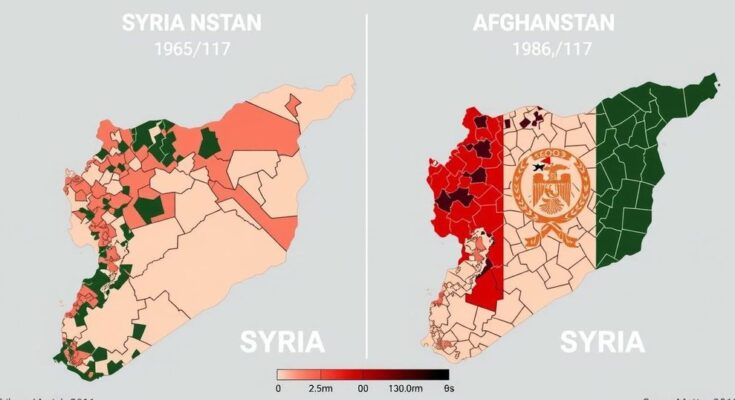This article examines the military equipment losses suffered by Russia in Syria and the United States in Afghanistan, evaluating the implications of these losses in light of ongoing conflicts and historical arms relationships. Both nations left behind substantial arsenals during the fall of their allied governments, but the strategic significance of Russia’s losses in Syria appears greater, especially given its current military challenges in Ukraine.
The recent collapse of the Syrian government has ignited comparisons to the fall of Afghanistan three years prior, particularly regarding the military assets left behind by their respective patrons, the United States and Russia. Both governments faced a rapid disintegration of their armed forces, leaving behind significant quantities of military equipment, albeit under different circumstances and implications. While Russia’s armaments were predominantly Soviet-era systems associated with a long history of military cooperation with Syria, the US left behind a mix of modern military assets valued at billions. Thus, a crucial question arises: Who ultimately lost more weapons?
The Russian-Syrian arms relationship has historical roots extending back to the Cold War, with the Soviet Union supplying vast quantities of military hardware. Data indicate that from 1950 to 1991, Soviet weapons constituted an astounding 94 percent of Syria’s total arms imports. Over the decades, Syria amassed a substantial arsenal, but much was lost in conflicts leading up to the civil war. Post-2011, while Russia endeavored to backfill these losses with new supplies, it ultimately proved insufficient for the regime’s survival.
In recent days, the Syrian regime reportedly left behind valuable military assets amidst chaos and conflict. Open-source monitors have documented significant battlefield losses, including tanks and other armored vehicles captured by Hayat Tahrir al-Sham (HTS) during their swift offensive. However, the recent Israeli airstrikes significantly impacted Assad’s military capabilities, with claims that they targeted substantial stockpiles of weapons, potentially impeding HTS’s access to those assets.
Comparatively, the situation in Afghanistan post-U.S. withdrawal saw the Taliban capturing approximately $7 billion worth of equipment, including vehicles and aircraft. Prior to the U.S. exit, significant U.S. military gear was left behind due to logistical challenges and the low military value of the equipment in a new conflict environment.
The stark contrast lies in the potential utility of the hardware left behind. The Russian losses, particularly with their ongoing military engagements in Ukraine, represent a considerable strategic setback. Consequently, whereas U.S. assets in Afghanistan lacked the caliber needed to pose a significant threat to stronger adversaries, the weapons left in Syria could have been operationally significant, exacerbating the strategic dilemma for Moscow.
The article compares the military equipment losses incurred by Russia in Syria and the United States in Afghanistan following the respective collapses of government forces in both countries. It highlights the historical relationships both superpowers had with their client states, the nature and scale of weaponry supplied, and evaluates the critical implications of these losses in light of ongoing military operations in regions like Ukraine for Russia and the evolving threats faced by the Taliban.
In conclusion, the analysis indicates that although both Russia and the United States faced considerable equipment losses following the collapse of their respective allies, Russia’s losses, particularly in terms of utility and military relevance, surpass those of the United States. As Russia contends with substantial operational challenges in Ukraine, the ramifications of their lost weapons in Syria could influence future military endeavors. Conversely, the type of equipment left by the U.S. in Afghanistan does not present as acute a loss in strategic military value.
Original Source: foreignpolicy.com




